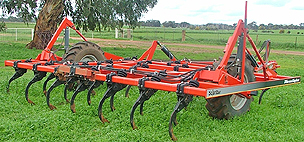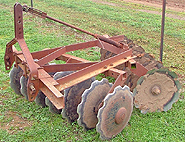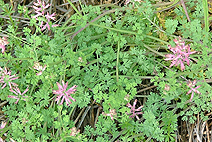module 10
Physical weed management
Objectives
At the end of this module, you will be able to:
- be able to describe the objectives of physical weed management
- be able to describe different tillage systems
- know the benefits and drawbacks of minimum tillage systems
Module Outline
- Introduction
- Objectives and types of tillage
- Other physical management methods
- Summary
- References and further reading
Introduction
This module considers the issues related to the effects of physical weed control with an emphasis on tillage practices on weed management. It will become evident that no one tillage system is appropriate in all circumstances and some flexibility is needed. It is also important to appreciate that weeds comprise only one aspect of a complex of issues related to tillage that need to be considered, including soil conservation. The present discussion specifically focuses on the impact of tillage practices on weeds.
Objectives and types of tillage
Tillage is the disturbance of soil by mechanical means usually as a preparation for sowing of crops or pastures. There are many different implements used for tillage and each has a specific purpose:
- chisel plough
- disc plough
- mouldboard plough
- rotary hoe
The different types and objectives of tillage are outlined in the following reading. You should particularly note the historical aspects in the development of tillage systems in Australia. The generally light erodable soils of much of Australia have meant that tillage has reduced in intensity over the past two decades.
You should also note the effects that different types of tillage have on seed germination. For example shallow burial of annual ryegrass seed encourages germination, whereas burial of Vulpia seed inhibits germination. Therefore, different types of tillage can encourage and discourage different weed flora.
|
In addition to their effects on weed germination, different
tillage implements have different soil disrupting characteristics. Such characteristics
will influence the choice of tillage implement and how often tillage is undertaken.
The characteristics of four different tillage implements are described in Table 10.1.
Table 10.1. A comparison of various types of tillage instruments and their actions on soil (modified from Pratley 1988)
| Action | Mouldboard plough | Disc plough | Chisel plough | Rotary hoe |
| Wear | Shares require replacement | Superior life | Points wear | Can be rapid |
| Movement of soil | Complete inversion | Partial inversion | Narrow furrows | Thoroughly mixes soil |
| Grinding of soil | Very little | Tendency | Little | Extensive |
| Shattering effect | Complete | Partial | Partial | Complete |
| Compacting effect | Considerable if soil too moist | Considerable if soil moist | Very little | Very considerable |
| Fineness produced | Very little | Considerable | Moderate | Very considerable |
| Surface trash | Well buried | Buries a large proportion | Left on surface | Buries a large proportion |
| Seedbed preparation | Requires secondary tillage | Ideal general cultivation | Ideal row crop cultivation | Makes soil fine in one operation |
| Control of weeds | Unsuited | Excellent | Can be excellent | Excellent |
The effects of various tillage implements on soil and existing vegetation:
Other physical management methods
Other physical methods can be used to remove weeds. Some such as roguing are widely used for specific weeds. Others such as mulching are used widely in particular industries. The following reading discusses the use of several physical methods for weed control and points out the industries in which they are used. You will encounter a more detailed discussion of some of these methods in Module 17A.
|
Summary
Tillage remains one of the tools in weed management. Used wisely it can provide a very valuable option but it clearly can be counterproductive with the wrong species. In the past we have tended to be too dogmatic in our approach when flexibility is the appropriate strategy.
The impact of tillage relates to the:
- dormancy characteristics of the weed species
- effects on the vigour of the crop
- ability of weeds to regenerate from plant fragments
- ability to achieve timeliness of operations
- ability of the weed to survive surface environmental fluctuations
- ability of the weed to germinate and emerge from depth
Go to Activity 10-1 |
References and further reading
Amor, RL 1985, ‘Seasonal emergence of weeds typically occurring in the Victorian cereal belt’, Plant Protection Quarterly, vol. 1, pp. 18-20.
Cheam, AH 1987, ‘Longevity of Bromus diandrus Roth. seed in soil at three sites in Western Australia’, Plant Protection Quarterly, vol. 2, pp. 137-139.
Cornish, PS & Pratley, JE, (eds) 1987, Tillage - New Directions in Australian Agriculture, Inkata Press, Melbourne, Vic.
Cuthbertson, EG 1967, ‘Skeleton weed - distribution and control’, NSW Department of Agriculture Bulletin 68.
Cuthbertson, EG, Leys, AR & McMaster, G 1976, ‘Silverleaf nightshade - a potential threat to agriculture’, Agricultural Gazette of NSW, vol. 87, pp. 11-13.
Dillon, SP & Forcella, F 1984, ‘Germination, emergence, vegetative growth and flowering of two silvergrasses, Vulpia bromoides and V. myuros’, Australian Journal of Botany, vol. 32, pp. 165-175.
Gramshaw, D & Stern, WR 1977, ‘Survival of annual ryegrass (Lolium rigidum Gaud.) seed in a Mediterranean type environment. II. Effects of short-term burial on persistence of viable seed’, Australian Journal of Agricultural Research, vol. 28, pp. 93-101.
Kloot, PM 1987, ‘Influence of environmental factors on the germination and establishment of barley grass (Hordeum glaucum) and annual ryegrass (Lolium rigidum)’, Australian Journal of Experimental Agriculture, vol. 27, pp. 525- 532.
Medd, RW 1987, ‘Weed Management on Arable Lands’, in PS Cornish & JE Pratley, (eds), Tillage - New Directions in Australian Agriculture, Inkata Press, Melbourne. pp. 222-259.
Moss, SR 1979, ‘The influence of tillage and method of straw disposal on the survival and growth of black-grass, Alopecurus myosuroides, and its control by chlortoluron and isoproturon’, Annals of Applied Biology, vol. 91, pp. 91-100.
Pratley, JE, (ed.) 1988, Principles of Field Crop Production, 2nd edn, Sydney University Press, Sydney.
Pratley, JE 1995, ‘Long term investigations of the effects of tillage practices on crop production at Wagga Wagga, New South Wales’, Australian Journal of Experimental Agriculture, vol. 35, pp. 885-892.
Reeves, TG and Smith, IS 1975, ‘Pasture management and cultural methods for the control of annual ryegrass (Lolium rigidum) in wheat’, Australian Journal of Experimental Agriculture and Animal Husbandry, vol. 15, pp. 527-530.
Wells, GJ 1970, ‘Skeleton weed in the Victorian mallee. 2. Effects of legumes on soil fertility, subsequent wheat crops and weed population’, Australian Journal of Experimental Agriculture and Animal Husbandry, vol. 10, pp. 622-629.
Self assessmentDo you know:
|











